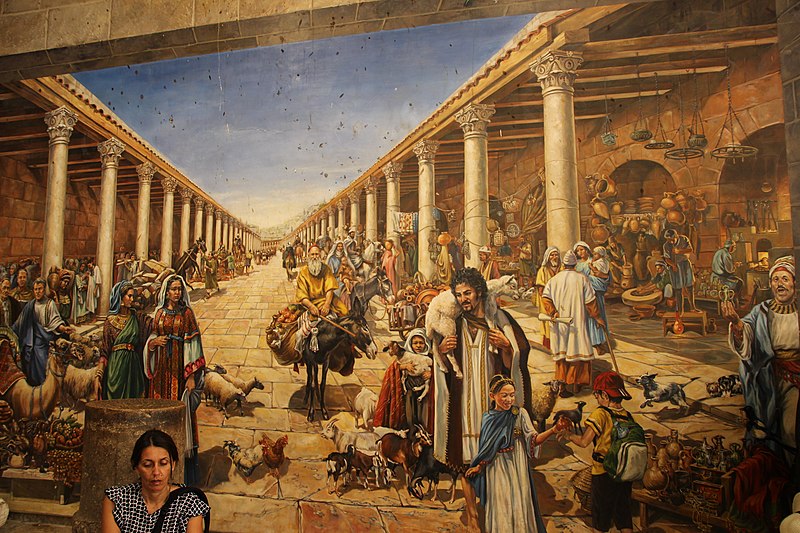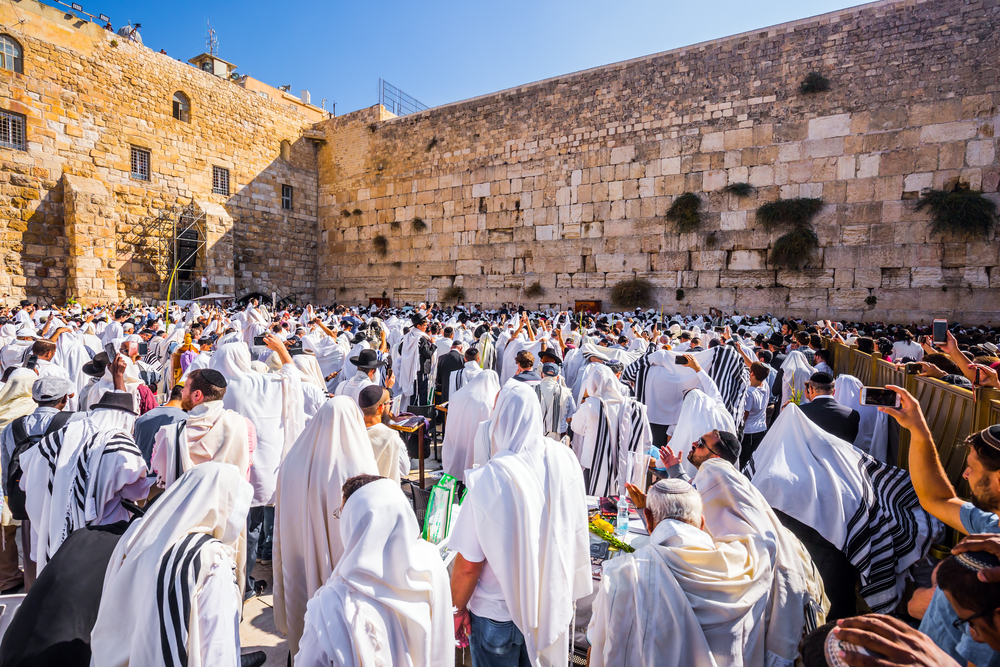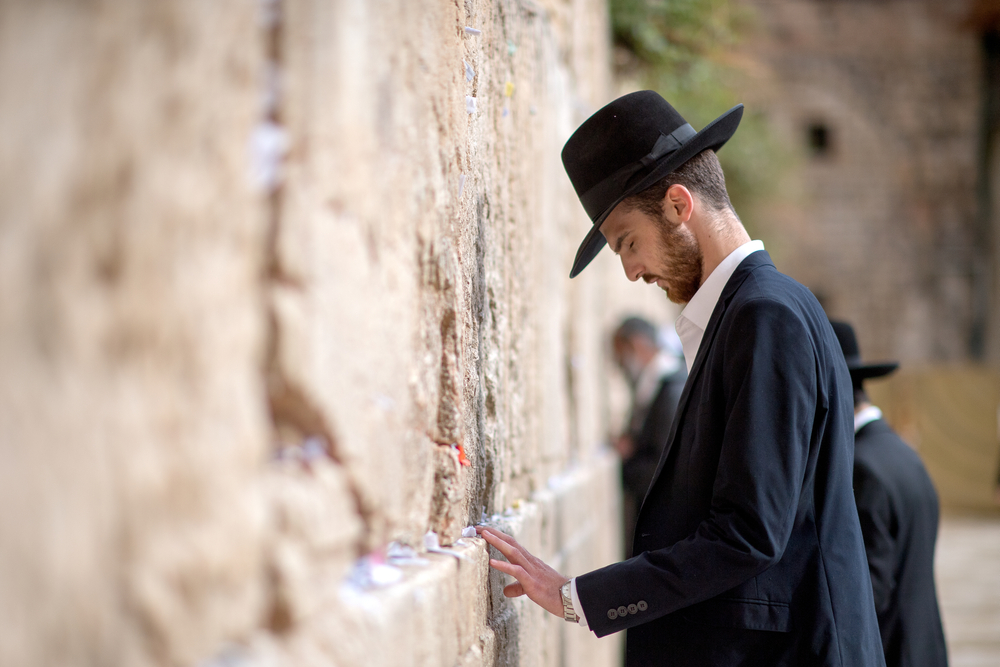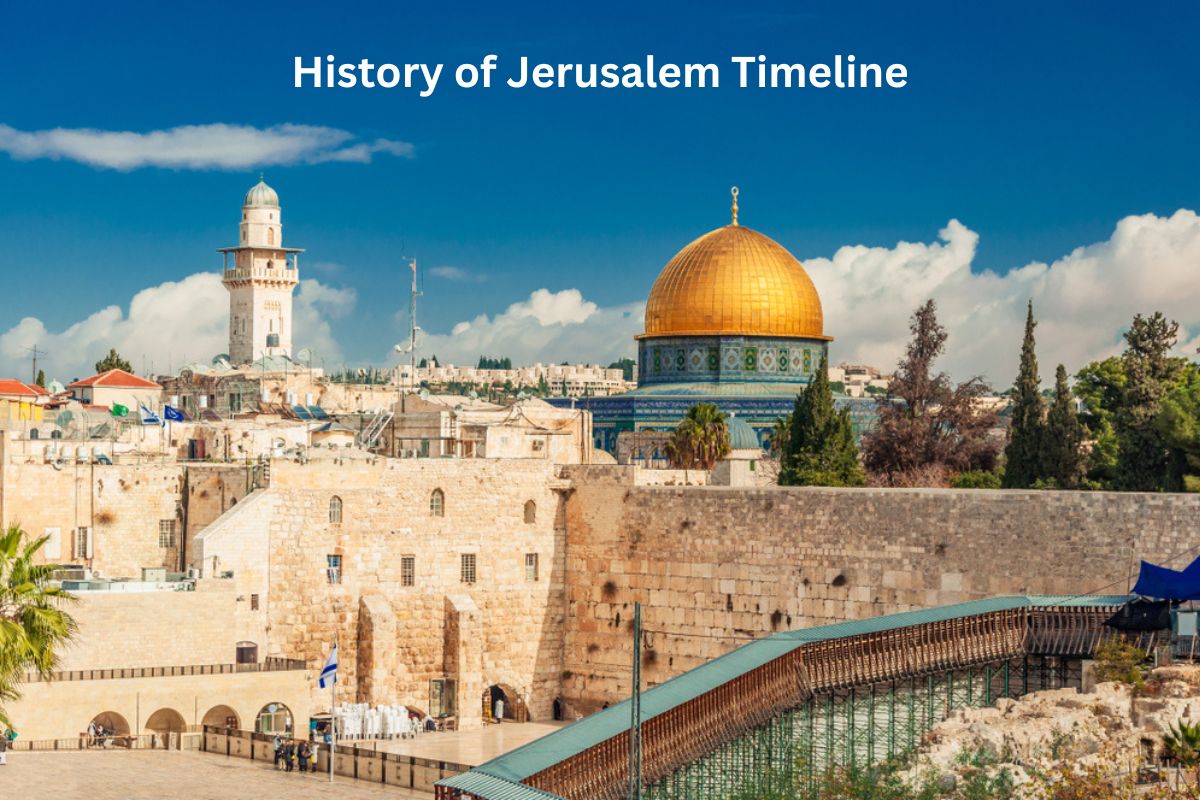Jerusalem, one of the world’s oldest and most historically significant cities, boasts a rich and complex history that spans millennia.
Situated at the crossroads of three major religions—Judaism, Christianity, and Islam—Jerusalem has been a center of faith, culture, and political strife throughout its existence.
Its story encompasses the rise and fall of empires, the construction and destruction of religious sanctuaries, and the enduring hopes and tensions of diverse communities.
In this exploration, we delve into the chronicles of Jerusalem, from its ancient origins to its modern-day status as a city at the heart of international diplomacy and ongoing conflict
| Period | Key Events |
|---|---|
| Ancient History | 4000 BCE – Early settlements in the area. 1000 BCE – King David establishes Jerusalem as the capital of the United Kingdom of Israel. 957 BCE – Solomon builds the First Temple (Solomon’s Temple). 586 BCE – Babylonians, under King Nebuchadnezzar II, destroy Solomon’s Temple and exile the Jewish population (Babylonian Captivity). |
| Persian and Hellenistic Period | 538 BCE – Persian King Cyrus the Great allows Jews to return and rebuild the Second Temple. 332 BCE – Alexander the Great conquers Jerusalem, marking the Hellenistic influence on the region. |
| Roman Period | 63 BCE – Roman general Pompey captures Jerusalem, making it a Roman province. 37-4 BCE – Herod the Great, a Roman client king, extensively renovates and expands the Second Temple (Herod’s Temple). |
| Judean Revolts and Roman Destruction | 66-73 CE – First Jewish-Roman War, resulting in the siege and destruction of Herod’s Temple in 70 CE. 132-135 CE – Second Jewish-Roman War, known as the Bar Kokhba Revolt, leading to Jewish expulsion from Jerusalem and the renaming of the city as Aelia Capitolina by the Romans. |
| Byzantine and Early Islamic Period | 313 CE – Emperor Constantine legalizes Christianity with the Edict of Milan. 326 CE – Construction of the Church of the Holy Sepulchre, a significant Christian site. 638 CE – Islamic Caliph Umar ibn al-Khattab captures Jerusalem, beginning the city’s Islamic era. |
| Islamic Caliphates and Crusader Period | 1099 CE – The First Crusaders capture Jerusalem and establish the Kingdom of Jerusalem. 1187 CE – Saladin retakes Jerusalem from the Crusaders. |
| Ottoman Empire | 1517 CE – Jerusalem comes under Ottoman rule when the Ottomans defeat the Mamluks. |
| British Mandate and Modern Era | 1917 CE – British forces capture Jerusalem from the Ottomans during World War I. 1947 – The United Nations approves the partition plan for Palestine, leading to the establishment of the State of Israel in 1948. |
| Post-1948 | 1948-1967 – Jerusalem is divided between Israel and Jordan, with the western part becoming Israel’s capital and the eastern part (including the Old City) under Jordanian control. 1967 – Six-Day War results in Israel’s capture of East Jerusalem, including the Old City and the Western Wall. |
| Modern Conflicts and Diplomacy | 1980 – Israel officially annexes East Jerusalem, a move not recognized by the international community. Ongoing conflict and negotiations continue over the status of Jerusalem, with both Israelis and Palestinians claiming it as their capital. |
Timeline of the History of Jerusalem
Ancient History:
Early Settlements (4000 BCE): Jerusalem’s history dates back to around 4000 BCE when it was settled by Canaanite tribes. It served as a small town during this early period.
King David’s Reign (1000 BCE): One of the most significant events in Jerusalem’s ancient history was the reign of King David, who established the city as the capital of the United Kingdom of Israel. Under his rule, Jerusalem began to grow in importance and became a center of political and religious life.
Also Read: Jewish History Timeline
Construction of Solomon’s Temple (957 BCE): King Solomon, David’s son, is credited with building the First Temple in Jerusalem, known as Solomon’s Temple.
This magnificent structure became the central place of worship for the Israelites and housed the Ark of the Covenant. It played a pivotal role in the religious life of the ancient Israelites.
Babylonian Exile (586 BCE): In 586 BCE, the Babylonians, under King Nebuchadnezzar II, conquered Jerusalem and destroyed Solomon’s Temple. This event marked a tragic period in Jerusalem’s history known as the Babylonian Captivity. The Jewish population was exiled to Babylon, and the city lay in ruins.

Persian and Hellenistic Period:
Return from Exile (538 BCE): After the conquest of Babylon by the Persians, King Cyrus the Great issued the Edict of Cyrus, allowing the Jewish people to return to their homeland. This marked the beginning of the Persian period in Jerusalem’s history and the gradual reconstruction of the city.
Reconstruction of the Second Temple (538-515 BCE): Under Persian rule, the Jewish exiles began rebuilding the Second Temple in Jerusalem. This marked a significant religious and cultural revival for the Jewish people.
Also Read: Jerusalem Facts
Alexander the Great’s Conquest (332 BCE): In 332 BCE, Alexander the Great conquered Jerusalem, marking the start of Hellenistic influence in the region. The city’s culture and administration became heavily influenced by Greek customs and traditions during this period.
Roman Period:
Roman Conquest (63 BCE): The Roman general Pompey captured Jerusalem in 63 BCE, making it a Roman province. Jerusalem’s political and religious life came under Roman control.
Herod’s Temple (37-4 BCE): Herod the Great, a Roman-appointed client king of Judea, embarked on a massive reconstruction project in Jerusalem. He expanded and renovated the Second Temple, which became known as Herod’s Temple. This temple complex was a remarkable architectural achievement and a major center of religious life.

Judean Revolts and Roman Destruction:
First Jewish-Roman War (66-73 CE): The First Jewish-Roman War, also known as the Great Jewish Revolt, began in 66 CE when Jewish rebels in Jerusalem and Judea revolted against Roman rule.
The conflict resulted in a prolonged and brutal siege of Jerusalem by the Roman legions under the command of General Titus. In 70 CE, the Romans breached the city’s defenses and captured Jerusalem. The outcome was the destruction of Herod’s Temple, a pivotal moment in Jewish history.
Second Jewish-Roman War (132-135 CE): The Second Jewish-Roman War, also known as the Bar Kokhba Revolt, erupted in 132 CE when Jewish leader Simon bar Kokhba led a rebellion against Roman rule.
The Romans responded with a massive military campaign, resulting in the defeat of the Jewish rebels. In the aftermath, the Romans renamed Jerusalem Aelia Capitolina, and Jews were barred from the city.
Byzantine and Early Islamic Period:
Edict of Milan (313 CE): The Byzantine period began with the rise of the Roman Emperor Constantine, who issued the Edict of Milan in 313 CE. This edict granted religious tolerance and legalized Christianity, marking a significant shift in the religious landscape of Jerusalem.
Construction of Christian Holy Sites (326 CE): Under Byzantine rule, Jerusalem became a major center for Christianity. In 326 CE, Constantine’s mother, Helena, oversaw the construction of significant Christian holy sites, including the Church of the Holy Sepulchre, believed to be the site of Jesus Christ’s crucifixion and burial. These constructions further solidified Jerusalem’s status as a center of Christian pilgrimage.
Islamic Conquest (638 CE): In 638 CE, Islamic Caliph Umar ibn al-Khattab captured Jerusalem, marking the beginning of the city’s Islamic era. The Islamic Caliphate respected the religious significance of Jerusalem and allowed religious freedom for Christians and Jews.
The Dome of the Rock and the Al-Aqsa Mosque were later constructed on the Temple Mount during the Islamic period, adding to the city’s religious significance.
Coexistence and Pilgrimage: During the Byzantine and Early Islamic Periods, Jerusalem was a city of religious coexistence. Christians, Jews, and Muslims lived in proximity, each with their own holy sites. Pilgrims from across the Mediterranean world visited Jerusalem to worship at these sites, contributing to the city’s rich religious tapestry.

Islamic Caliphates and Crusader Period:
Islamic Caliphates: After the Islamic conquest of Jerusalem in 638 CE, the city became an integral part of the Islamic Caliphates, including the Umayyad and Abbasid Caliphates.
During this time, Jerusalem continued to be a significant religious center for Muslims, with the construction of religious buildings and the preservation of Islamic holy sites on the Temple Mount.
First Crusaders Capture Jerusalem (1099 CE): In 1099 CE, during the First Crusade, Jerusalem was captured by Christian Crusaders.
The city was the focal point of Christian pilgrimage, and its capture marked the establishment of the Kingdom of Jerusalem, a Christian Crusader state in the region.
This period saw the construction of several Christian churches and fortifications, including the Church of the Holy Sepulchre.
Saladin Retakes Jerusalem (1187 CE): In 1187 CE, the Muslim military leader Saladin, known for his chivalry and military prowess, recaptured Jerusalem from the Crusaders.
Saladin’s recapture of the city marked the end of the Christian Crusader control over Jerusalem and the reunification of the city under Muslim rule. He allowed Christians to continue visiting their holy sites, fostering a sense of coexistence during this period.
Ottoman Empire:
Jerusalem Under Ottoman Rule (1517 CE): In 1517 CE, Jerusalem came under Ottoman rule when the Ottoman Empire, under Sultan Selim I, defeated the Mamluks.
During the Ottoman period, Jerusalem saw the construction of several significant architectural works, including mosques, schools, and public buildings.
The Ottoman Empire was known for its religious tolerance, and Jerusalem remained a diverse and vibrant city with a mix of Muslim, Christian, and Jewish communities.
British Capture of Jerusalem (1917 CE): During World War I, British forces, led by General Edmund Allenby, captured Jerusalem from the Ottomans in December 1917. This event marked the end of centuries of Ottoman rule in the city and the beginning of the British Mandate for Palestine.

British Mandate and Modern Era:
Balfour Declaration (1917): In 1917, the British government issued the Balfour Declaration, which expressed support for the establishment of a “national home for the Jewish people” in Palestine. This declaration had far-reaching consequences for the demographic and political landscape of Jerusalem and the region.
United Nations Partition Plan (1947): In 1947, the United Nations approved the partition plan for Palestine, leading to the establishment of the State of Israel in 1948. Jerusalem was intended to be an international city under the UN plan, but this provision was not implemented due to the outbreak of the Arab-Israeli War.
Jerusalem’s Division (1948-1967): Following the 1948 Arab-Israeli War, Jerusalem was divided. West Jerusalem became part of Israel, serving as the country’s capital, while East Jerusalem, including the Old City, was controlled by Jordan. During this period, Jewish access to the Western Wall, a significant religious site, was restricted.
Six-Day War (1967): The Six-Day War in 1967 resulted in Israel’s capture of East Jerusalem, including the Old City and the Western Wall. Israel’s control over the entire city marked a significant turning point in its modern history and ignited international debates over the status of Jerusalem.
Israel’s Annexation of East Jerusalem (1980): In 1980, Israel passed the Basic Law: Jerusalem, Capital of Israel, which declared Jerusalem to be the “complete and united” capital of Israel. This move was not internationally recognized, and it remains a subject of dispute in the Israeli-Palestinian conflict.
The United Nations Security Council passed Resolution 478 in response, condemning Israel’s annexation of East Jerusalem and calling on member states to withdraw their diplomatic missions from the city.
Modern Conflicts and Diplomacy:
Ongoing Conflict: Jerusalem remains a focal point of the Israeli-Palestinian conflict. Both Israelis and Palestinians claim Jerusalem as their capital, with competing historical, religious, and political narratives.
The status of Jerusalem has been a major obstacle in peace negotiations, as each side seeks sovereignty over the city’s eastern and western parts.
International Mediation: Various international bodies and organizations, including the United Nations and the European Union, have called for a negotiated settlement on the status of Jerusalem as part of a broader peace agreement.
International mediators and diplomats have been involved in efforts to find a solution that addresses the competing claims and ensures access to holy sites for all parties.
Jerusalem Today: Today, Jerusalem is a vibrant and diverse city, home to a mix of Jewish, Muslim, Christian, and other communities. It is a center of religious worship and pilgrimage for adherents of Judaism, Islam, and Christianity. The Old City of Jerusalem, with its historic and religious sites, remains a UNESCO World Heritage Site and continues to draw visitors from around the world.
